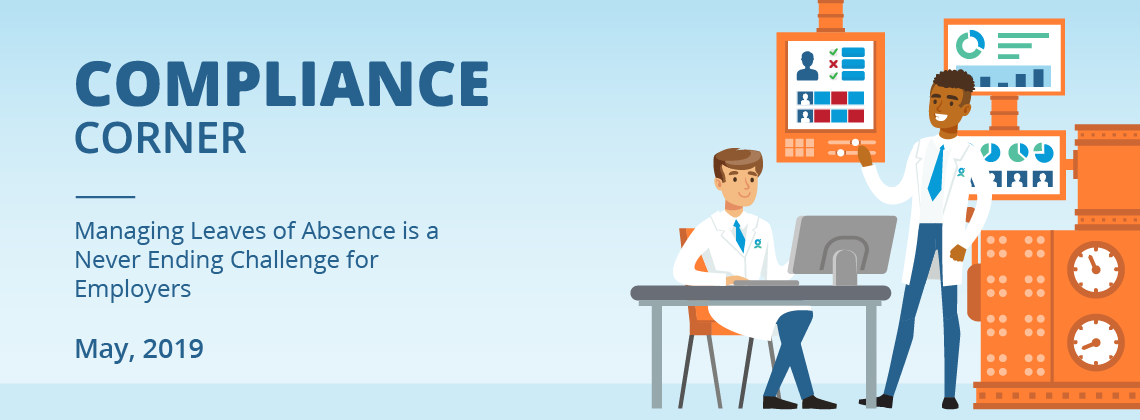Managing Leaves of Absence is a Never Ending Challenge for Employers


Paul Kramer
Director of Compliance
Employers in the United States and Canada know far too well that in certain situations employees are entitled to legally protected leaves of absence from work. A wide range of laws govern workplace leaves for reasons related to personal and family illness, pregnancy, disability, organ donation, crime-victim status, military service, the death of a family member, personal emergencies, and family responsibilities. The challenges employers face to properly manage these leaves does not end when an employee’s time off request is approved but extends to many other issues, including:
Recordkeeping and tracking leave.
Recordkeeping is a key component of compliance. Fully documenting an employee’s leave of absence, including the precise amount of time off granted, will go a long way toward protecting employers from allegations that they failed to comply with a leave law or policy.
Consistently applying leave rules.
Employers should treat similarly situated employees the same when it comes to leaves of absence. Failing to treat employees consistently can result in claims of discrimination and leave interference, which can be difficult and costly to defend even if the allegation is untrue.
Scheduling work around employee leave.
Scheduling workers can be complicated even under normal circumstances, but an employee’s extended leave can result in lost production and increased labor costs if not handled properly.

Digitalize Compliance Processes to Reduce Risk
Learn more effective ways to demonstrate compliance with the complex matrix of labor laws, while also keeping costs down and reducing risks.
Leave abuse.
With numerous laws protecting employee rights, employers often find it difficult to clamp down on leave abuse. Nevertheless, the ability to recognize leave abuse and to discipline employees who engage in it can save organizations money and send an important message to workers that job-protected leave is only for those who truly need time off.
Verifying the reason for leave.
Employers should not accept leave requests at face value. If the law provides the right to request certification from an employee to verify the reason for leave, employers should do it. But remember, not all leave laws allow requests for certification in all circumstances. Awareness of when and how to verify a worker’s need for time off can keep employers out of trouble.
Leave interaction.
Many leave laws overlap and sometimes conflict with each other. And since employees may be entitled to more than one type of leave in a situation, it’s important for employers to know how leaves interact. For example, can an employer require an employee to take two or more leaves concurrently or do they function independently of each other?

Intermittent leave.
Under certain circumstances employees may be entitled to take leave intermittently. It is essential for employers to immediately determine the expected frequency and duration of intermittent leave by insisting that the medical practitioner provide an estimate of how often the employee will require time off. And try to work out a leave schedule with the employee as far in advance of the leave as possible.
Return to work issues.
When an employee returns from leave, they must usually be reinstated to their former position or to an equivalent job, unless an exception applies. A position is considered equivalent only if it is virtually identical to the employee’s former job in terms of benefits, pay, and other terms and conditions of employment. Failing to return an employee to the same or to an equivalent position can lead to claims of retaliation.
Manage leaves of absence properly.
Today’s employees are well informed regarding their leave rights, and lawsuits to enforce these rights are becoming more common and more costly. To avoid litigation or to put themselves in the best position to defend against potential claims, employers must be very careful in all aspects of leave management. Properly managing leaves of absence from beginning to end can save employers headaches, money, and time.
More Awesome Content!
Embedding an ‘Eyes Wide Open’ Mindset Into HR Technology Selection
Gartner guides teams responsible for deciding on their organization’s next HR technology investment to set themselves up for success.
5 Workforce Management Secrets to Thrive in 2021 and Beyond
Download this eBook to learn the 5 secrets that will help your organization shift from surviving to thriving now and in the future and learn how the right workforce management solution can empower your initiatives.
Reshaping Workforce Management Strategies to Meet Growing Employee Expectations
See how evolving preferences and pivotal factors have led to a transformative shift in workforce expectations.




